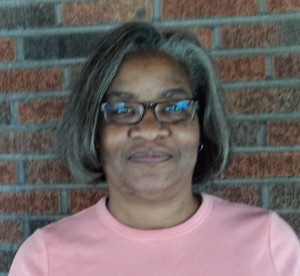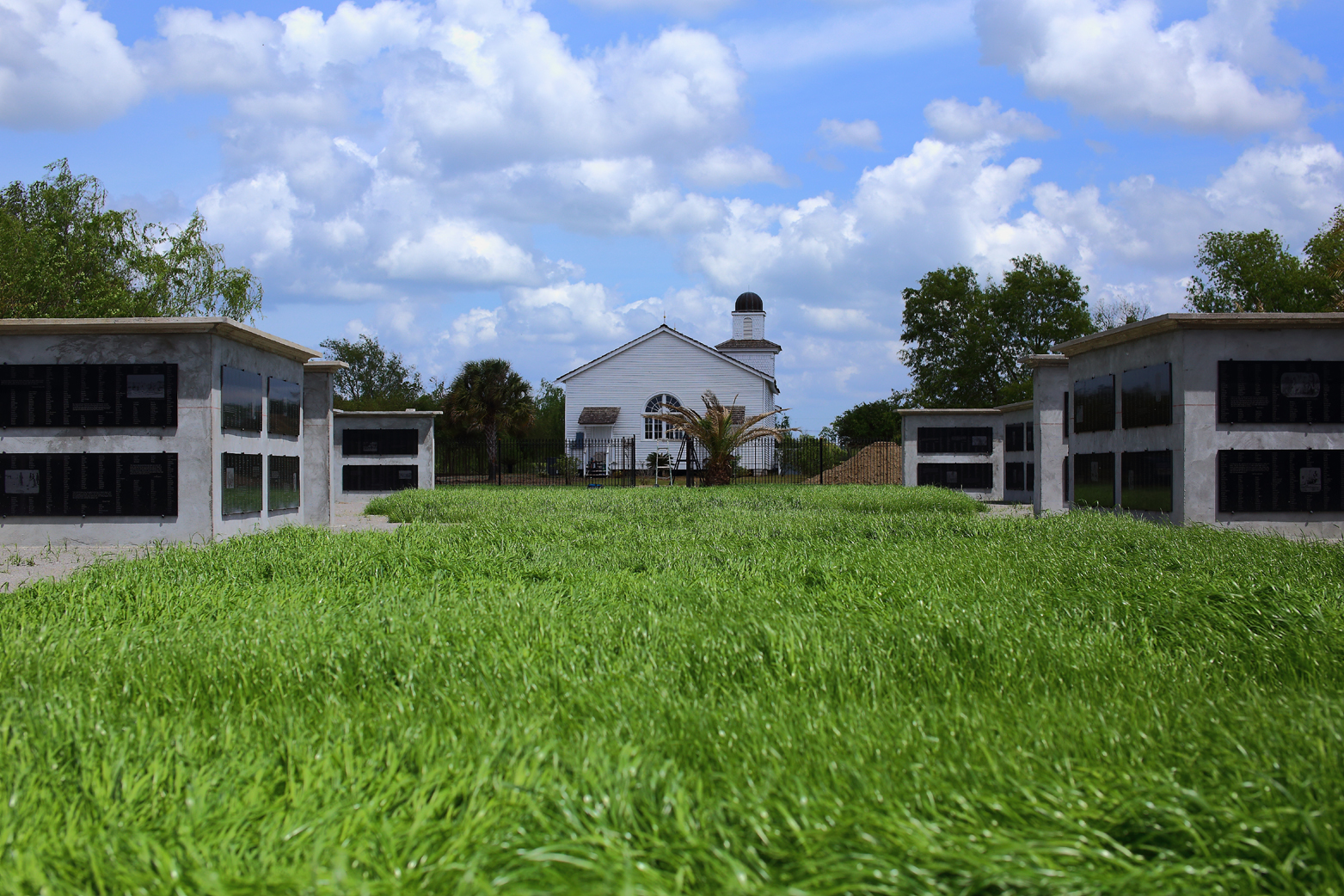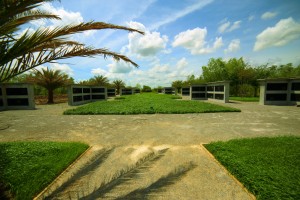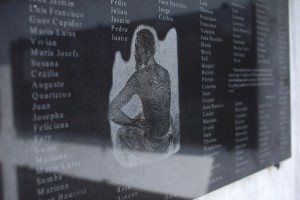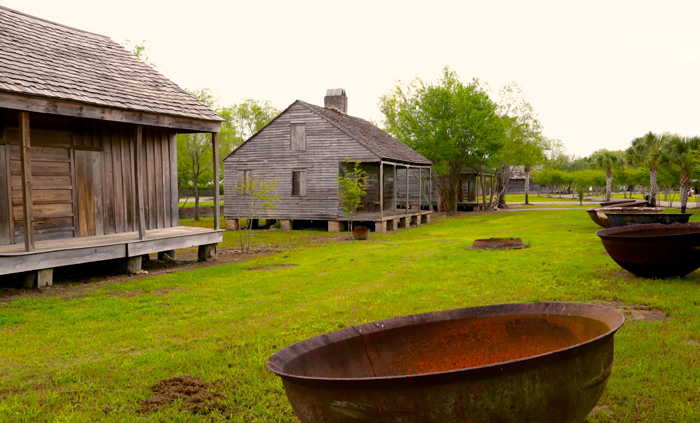A Visit to Whitney Plantation
Saturday, September 19th, 2015By Melva Tolbert, Oberlin Heritage Center volunteer
September 9, 2015
While recently visiting my daughter, who resides in New Orleans, Louisiana, we decided to spend an afternoon at the Whitney Plantation in Wallace, LA. Jessica is a history major and an elementary school teacher. She had been to the plantation before and was pleasantly surprised with the approach that was taken that distinguished it from other plantation tours. The focus was not on the owners of the plantation, but on the enslaved people.
We drove almost an hour away from the city and passed by other plantations on our way. As we pulled into the large gravel parking lot you could see the large white “big house”. We entered the welcoming center which sold tickets, books and displayed the journey that people from western African had taken from their homeland to the Caribbean Islands, the Atlantic coast and Gulf of Mexico to work the land. The display also illustrates the involvement of the early Catholic popes and the British monarchies involvement in the early slave trade.
Our tour guide gathered together me, my daughter and four young women from Europe on an hour and fifteen minute walk through life in Louisiana in the early 1800s. Our first stop was Antioch Baptist Church where we watched a video about the plantation and were introduced to some of the children that worked the land. The plantation was purchased in 1752 by Ambroise Heidel, a German emigrant and he became wealthy producing indigo. In the early 1800s, his son transitioned the plantation to sugar which was a much more physically demanding product and required many enslaved people.
The Antioch Baptist Church (seen here at a distance behind the slave memorial) was founded by former slaves in 1868. Originally located about 8 miles from the plantation, it was moved to the Whitney in 1999. Photo courtesy of Whitney Plantation.
We then visited an outdoor memorial that recorded the words and honored the former enslaved children and families. These words were captured through the Federal Writers Project (FWP) that was a part of the Works Progress Administration of Franklin D. Roosevelt. The FWP supported writers during the Great Depression and interviewed former enslaved people from the South.
The Allées Gwendolyn Midlo Hall is the name of the slave memorial on the property that is dedicated to the 107,000 people enslaved in Louisiana in the antebellum era. Photo courtesy of Whitney Plantation.
The Wall of Honor honors all the people who were enslaved on the Whitney Plantation. Their names and the information related to them (origin, age, skills) were retrieved from original archives and engraved on granite slabs. Photo courtesy of Whitney Plantation.
We continued our walk of the plantation that included the slave quarters, blacksmith shop, overseers home, a jail for runaway slaves, the kitchen and finally the owner’s house. It was interesting to note that the kitchen resembled the slave quarters, but was actually a part of the owner’s house. Their food was prepared and then transported to the pantry in the owner’s house. During this time, our guide detailed the conditions that the enslaved were working under including starvation, castrations, imprisonment, separation from family and mixing with the owner’s family.
Before the Civil War, the Whitney Plantation counted 22 slave cabins on its site. The large iron cauldrons dotting the plantation landscape were used in refining sugar cane harvested from the fields. Photo courtesy of Whitney Plantation.
After 1865, the slaves were free, but they had no education, large families and still felt tied to the land. The former enslaved became sharecroppers and continued to work the land up until it was outlawed in 1965. The Whitney Plantation was purchased by another owner, preserved and is a part of the National Register of Historic Places. The new owner wants to educate the public by telling the story of the enslaved. Additionally, he wants to help people understand some of the challenges we continue to face today is of plantation life.
On my way out, I purchased, Chained to the Land, Voices of Cotton & Cane Plantations by Lynette Ater Tanner. I summarized a few of the stories and they are as follows:
Story 1 – Julia Woodrich was interviewed on May 13, 1940 at the age of 89. When the master died, her family was sold. She never saw her brothers or sisters again and because she was so young she remained with her mother. Her mother had fifteen children and never by the same man. Each time her mother was sold she had to take on another man, even the master. She was considered a good breeder.
After the master and misses died, the younger master took over and split up the money and property. Julia remembers when they were freed because the master could no longer take care of them so they lived off of fish and berries. She remembers that the master would come get her sister and take her to his quarters and then inquired the following day how she felt.
Story 2 – Mrs. Webb was interviewed August 17, 1940, but unsure of her age. She remembers her master being the cruelest in St. John the Baptist Parish. If an enslaved person was disobedient, he would place him in a box and they could not move. This master was known for having very attractive slaves. He heard about a slave with a fine physique so he bought him. Because this enslaved person had been raised with the master’s children he was not used to harsh work, so he refused the hard work. The master day after day directed him to work in the fields and each time he refused. He was then told by the master to dig a hole, which he did. The next day he was told by the master to get into the hole and the master shot him and he fell down in the hole.
Story 3 – Peter Barber was interviewed August 23, 1940 and estimated his age to be 96 years old. He was proud in describing his life as eventful. He acknowledges that he was born into slavery on a farm in Charlottesville, Virginia. He refers to his master as ‘good’ as long as you were working. He remembers being sold to another master who was a tobacco farmer for $900.00 using both union and confederate money. Because there was talk of sending him to the Blue Mountains to fight he ran away. Peter did not talk a lot, but he listened and he knew what the fighting was all about. Peter and a friend, Jimmie, jumped on a boat that was headed for Cincinnati. Both of them were put off of the boat since they knew Peter and Jimmie were not passengers. They walked the remainder of the way. While in Cincinnati, his friend joined the Army, but they delayed taking Peter. Now separated from his friend, he took a job on a boat that traveled up and down the Ohio River then another boat to New Orleans. He never joined the army and traveled the Mississippi for fifty-six years as a loner. He is proud that his travels allowed him to see 13 presidents, but he never got to see Abe Lincoln.
OHC Note: In 2014, the Whitney Plantation opened its doors to the public for the first time in its 262 year history as the only plantation museum in Louisiana with a focus on slavery. For more information, visit www.whitneyplantation.com.





